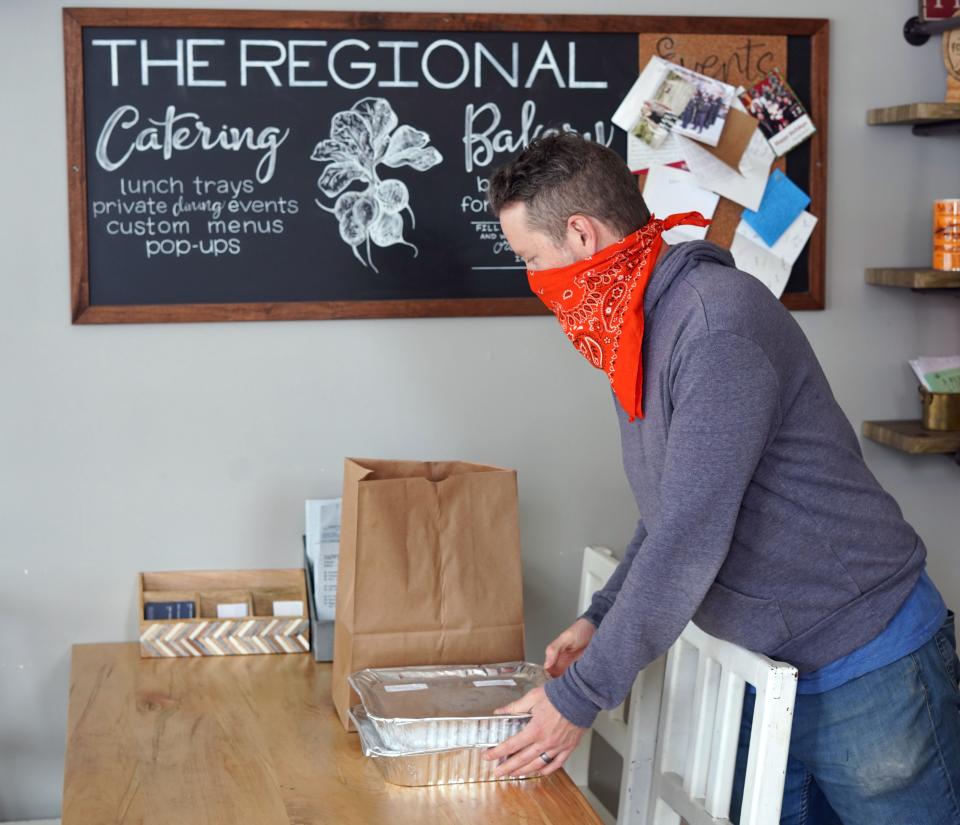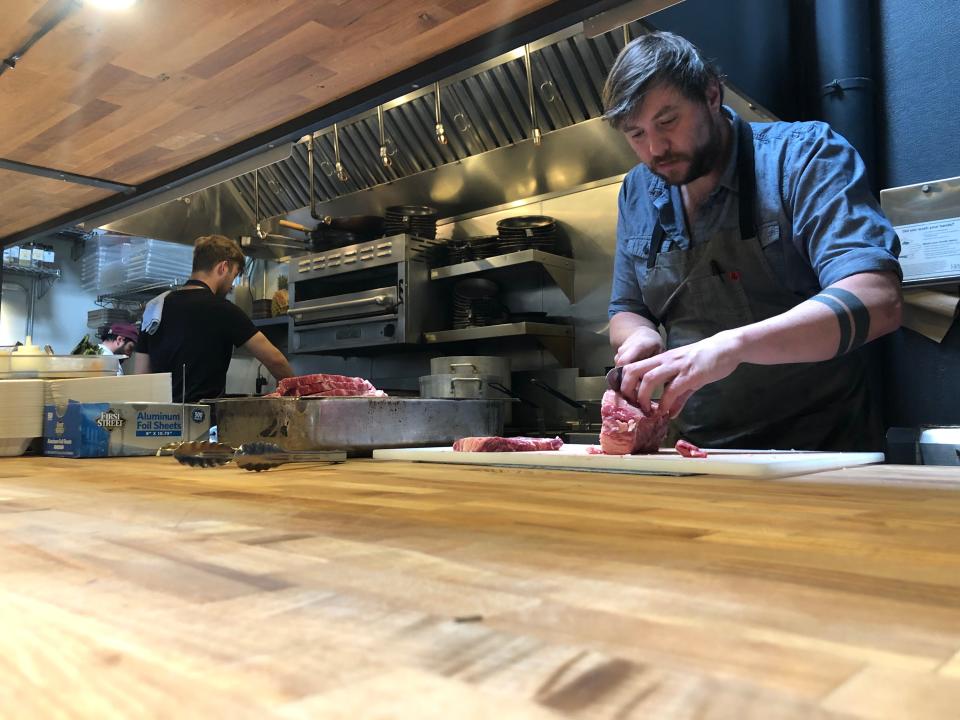Restaurants face tough choice: Stay open despite risks, or close with no guarantee of reopening
PORTLAND, Oregon – Andy Ricker had a plan.
After Gov. Kate Brown ordered all bars and restaurants to stop on-site dining and pivot to only takeout because of increasing coronavirus cases, Ricker, a James Beard-award-winning chef who operates six Thai restaurants in Portland, instructed his kitchen staff to wear gloves and stay 6 feet apart. By installing strict protocols, he expected Pok Pok would still be able to satisfy Portlanders’ cravings for sticky fish sauce wings, the restaurant’s signature dish.
Then Ricker dropped by one of the restaurants one day and “saw one of our guys kinda slipping – he had his gloves off, he was standing within 2 feet of another guy, and I knew right then, we had to close. We just don’t have the discipline to stay far away from each other in the kitchen.”

To Ricker, it was an obvious choice. He shuttered all of his restaurants, laying off more than 150 employees in the process.
“All it takes is one person getting sick, and then you have it on your conscience, that somebody caught this terrible disease, and what if they give it to their grandma?” he says.
As coronavirus sweeps across the USA, grinding the economy to a halt, chefs and restaurant owners have been forced to make a difficult choice: Stay open in hopes of making some money while risking the safety of their employees and customers, as well as everyone those people encounter, or shut down and lay off workers, not knowing when, or whether, they’ll reopen.
“My God, we are watching the food and drink industry and small businesses fall apart right now,” says Donna Moodie, who closed Marjorie, an eclectic American restaurant in central Seattle. “I am hopeful we can figure out a way to put it back together, but I’m not sure how we’re gonna do it. We’re gonna have to reinvent ourselves in so many ways.”
The risks to staying open are many: Though there's little concern about the virus spreading through food, it can live on takeout containers for a couple of days and is typically spread by people being in close proximity. It's impossible to monitor delivery drivers 24/7; shortly after New York started self-isolating, a photo circulated on social media of dozens of delivery drivers bunched around each other, waiting to pick up orders and not maintaining 6 feet of distance. Some restaurants tried to stay open but couldn't do it. In Los Angeles, prominent chef Nancy Silverton had to close her restaurants – including one that was feeding only laid-off hospitality workers – after she tested positive for the virus herself.
There's no way to know for sure whether restaurant workers practice social distancing outside the kitchen or how many other people they contact. "What if two people take a break and share a cigarette?" Ricker says.
At Portland restaurant Quaintrelle, chef de cuisine Ryley Eckersley is known for his farm-to-table tasting menus that often “push people outside their comfort zones,” he says. In the wake of coronavirus, Eckersley rejiggered the menu to focus almost entirely on comfort food, such as chicken fried steak, fried chicken and split pea soup.
Quaintrelle trimmed its staff from 15 to four, but Eckersley acknowledges that it’s next to impossible to stay 6 feet apart in a small kitchen with “a walk-in [cooler] roughly the size of a New York City closet.” They wear protective gear as necessary, but Eckersley hates it.
“Putting on gloves is like rubbing numbing gel all over your hands. I know exactly how much salt I need based on how it feels between my fingers. Do you know how hard it is to season meat with gloves on?” he says.

Takeout has worked for Quaintrelle, but Eckersley is under no illusions that it’s some sort of cash cow. “There’s no way we’re making money,” Eckersley says, explaining that the biggest night of takeout totaled about $2,000 worth of orders. In a typical dine-in night, Quaintrelle doubles or triples that number.
In Fort Collins, Colorado, Kevin Grossi worries about keeping his customers and employees safe while being able to pay for food and salaries.
Grossi is the owner of The Regional, a New American-focused restaurant that typically serves comfort food such as fried chicken and grits and leans heavily on local produce. He says being a restaurateur “means always being in debt anyway,” so taking a hit during coronavirus isn’t necessarily out of the ordinary.
Grossi says he doesn’t feel like he has the luxury to close, especially in a competitive marketplace.
“It’s definitely not making money,” says Grossi, who works in the kitchen wearing an orange bandanna as a makeshift mask. “It’s about keeping the breath in the building, keeping the wheels moving.”
Plus, he says, some customers simply need a change of pace: “You can only eat so many loaves of bread. And everybody’s making bread.”
Grossi cut the number of staff working each day to two – one cooking, one working the register and the online ordering. Usually he'd have as many as 10 people handling his 62-seat restaurant, which he says is basically a food truck now. Like most restaurants still open, The Regional encourages its customers to pay online to eliminate contact required by in-person payments.
Almost everyone agrees that pivoting to takeout isn't a way to rake in money.
Andy Fortgang, who along with James Beard-award-winning chef Gabriel Rucker, co-owns two Portland restaurants, Le Pigeon and Canard, says, “In the restaurant business, sales come in big numbers, and profits come in pennies.”
Restaurants already operate on excruciatingly thin margins: A 10% profit margin is considered hugely successful, but the reality is most restaurants operate with zero to 7% profits.
“I know exactly how much money we’re losing every single day,” Fortgang says. “Any time you close, you lose money. But when you close for a staff retreat, when you close for renovations, that’s a choice. This wasn’t a choice. It was a necessity.”

In the week before the governor shut down dine-in service, Fortgang and Ruckeragonized about what to do to keep their employees and customers safe. They decided they wouldn't take the risk of staying open.
“Honestly, it was a relief to actually make the decision, because the time leading up to the decision, the limbo, that was the worst part,” Rucker says. “Laying everyone off was horrible and nauseating, but also, this is happening across the entire world. It’s not like our employees were blaming us.”
Like others caught in an impossible situation, Rucker and Fortgang tried to get creative during the crisis. Fortgang started selling six-packs of wines curated from Le Pigeon’s heralded wine list (the top six-pack retails for $995), and Rucker does cooking demos on Instagram Live, teaching viewers some of the restaurants' most famous dishes. It’s a family affair, as his wife, Hana, films and relays questions from viewers. (The main attractions, Rucker admits, are his three children, including Chef Freddy, 3, who chops up the same ingredients as dad and makes soup every night.) Fortgang says Rucker’s social media presence helps keeps Le Pigeon and Canard in people’s minds, which will hopefully translate to packed restaurants when everyone can open.
The longer social distancing and quarantine drags on, the more Rucker wonders if there’s a safe, responsible way his restaurants could offer some sort of takeout.
“A Le Pigeon meal crafted for the home cook – can we do it?” he says. “Right now, it’s just a germ of an idea. I’m not sure how it would work, and I think it would only be a couple times a week. I’m not a catering company.”
In Seattle, Moodie is considering a revamped menu that’s takeout-friendly and could help her make a little money. But she has concerns: Does she want to encourage people to leave their house when the governor ordered everyone to stay home? Is it feasible to procure the necessary number of gloves and masks, so her employees can stay safe? Is it even worth it if, as she says, "we're endangering lives for crumbs?"
Like many other restaurant owners, Moodie didn’t make it in time to get funding from the Paycheck Protection Program, the government loan aimed at helping small businesses keep their workers employed during the coronavirus crisis. The PPP ran out of money almost instantly, leaving small-business owners everywhere scrambling.
Moodie, who knows she’s a rarity as a woman of color owning a restaurant, wonders what it all means for the future.
“Being a black woman and a small-business owner, I think about the effect that has on the fabric of our city,” Moodie says. “Watching the way aid is rolling out, where it’s favoring larger corporate structures, what’s happening is that the process is causing us to lose the flavor and diversity of our city.”
She's grateful for a community that’s rooting for her to come back, for her good health and for a landlord who didn’t require her to pay rent in April and doesn’t expect it in May. She knows other businesses aren’t being shown that type of grace.

Elsewhere in Seattle, E. Lewis Rudd is grateful, too – mostly because he operates a business that thrives on takeout.
For more than 36 years, Ezell’s Famous Chicken, which operates 15 fast-casual fried chicken restaurants in the Northwest, has survived what Rudd, the president and CEO, calls “the three big Rs: redlining, recessions and racism.”
“I had a high level of confidence that we’d be OK because we’ve already gone through just about everything else,” Rudd says.
By staying open, the business has retained nearly 90% of its workforce, about 300 employees. Roughly 80% of Ezell’s sales are takeout, which means it didn’t have to make menu changes.
It made other adjustments, including protective glass shields at the counters and checkout stands in all the restaurants, and employees and guests are encouraged to wear masks at all times.
Rudd says he initially worried that employees wearing masks would scare guests. Now he sees it not only as a safety precaution but a move that will increase guests’ confidence in Ezell’s.
Still, there’s no way to be 100% safe and serve the public. Rudd says that after an employee tested positive, one location immediately closed.
This article originally appeared on USA TODAY: Coronavirus takeout, restaurants and workers: Should eateries be open?

